Reading the convention center
21 April 2012 – Cathy Stanton
It’s always a pleasure to reconnect with colleagues and friends at a conference, and to have face-to-face conversations that enrich to the increasingly digitized interactions that professional life entails. But the conference experience is also rich with ironies for me, probably because I can’t help thinking about how the kinds of environments in which we hold these gatherings–usually big downtown hotels and convention centers–have been created, how they fit within their social, spatial, and economic contexts, and how we of the mobile knowledge classes fit within them.
This kind of irony cropped up yesterday while I was having lunch with two colleagues from New England–people I tend to see more frequently at distant conferences than in our native settings. We all commented on that, and also on the disjunction between the topic we were meeting to talk about–our shared interest in finding a way to connect our public history work more closely with discourse and activism around climate change and environmentalism–and the fact that we were eating in a restaurant that proudly poured its imported-from-Fiji drinking water out of plastic bottles (“For the Planet” it said on the side). Given the tightness of conference schedules and the realities of several thousand people looking for a quick meal in the same sixty minutes, we didn’t have time to follow our consciences elsewhere, which is characteristic of a lot of the ways that we end up accommodating to contemporary capitalism and its energy-intensive way of living.
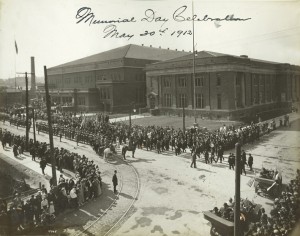
The 1909 Milwaukee Auditorium on the site of the current Frontier Airlines Center (Source: http://www.midwestairlinescenter.com/galleries/8-historicimagesfromthemilwaukeeauditorium)
These ironies are easier to ignore–but all the more troubling to me for that–within the bubble that is the convention center complex where the conference is taking place. This 1998 redevelopment on the site of an early 20th-century auditorium (itself built on the site of a late 19th-century industrial exposition building) is an immense structure whose street-level façade, shown at the top of this post, is apparently intended to evoke the German-American architecture in the surrounding downtown. To me it evokes the kind of generic convention-center architecture that is ubiquitous in cities trying to revitalize their downtowns, and the center’s website makes no bones about its economic mission: “to support Milwaukee’s economy by attracting visitors and wealth to the community.” There’s lots that’s interesting and beautiful in Milwaukee’s downtown, but there are also many signs of a city core that’s struggling to attract people and businesses: empty retail space, massive parking garages, a flagship department store converted into lofts.
One thing that caught my eye the other morning was a new “ghost sign” on an office building near the convention center. Older painted ghost signs have become artifactual symbols of historical depth, but the newer ones are a bit spooky, signalling the volatility of globalized capitalism and its effects on urban places. The name of the Frontier Airlines Center (née Midway Airlines Center) itself reflects this ephemerality.
And the interior of the convention center is also a fascinating study in the use of heritage display and place-making techniques to try to overcome what is essentially a “non-place.” It’s filled with quotes from Wisconsin literature (including the wonderful one below about pleasantness being “the machismo of the Midwest,” with people letting smiles hover on their faces “like the dare of a cat”).
There’s a mosaic map of the state in the entry foyer, with colorful insets for various products and industries. And alongside the escalator leading to the skywalk that connects the center with my hotel, there’s an exhibit of black and white photos focusing on polka, taken between 1976 and 1990. There’s even a button that promises polka music if you push it, although it seems to be out of order (“Polka, y u no play?” one conference-goer tweeted plaintively.)
The place is, in part, a pseudo-museum, using techniques of historical display to create an aura of “pastness” and “hereness” while servicing the needs of mobile capital and people. The irony of this for me is that at least this week, quite a number of those people have gathered to talk about the constructions of memory, history, sense of place, and community, without seeming to notice the ironic erasure or masking of local history by many of the spaces in which we meet. In inhabiting these spaces, are we accommodating to many of the kinds of conditions that we are actually critical of in our work? It sometimes seems that way to me (although it doesn’t keep me from accommodating to them along with everyone else–it just means I spend perhaps more time wondering about it!).
A timeline history of the convention center and its antecedents can be found at the bottom of the center’s “About” page.
~ Cathy Stanton





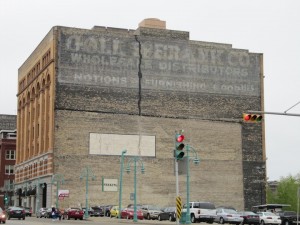
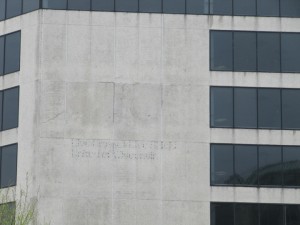

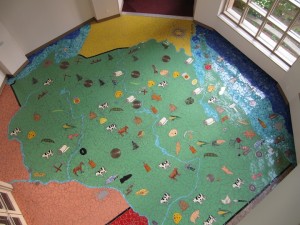
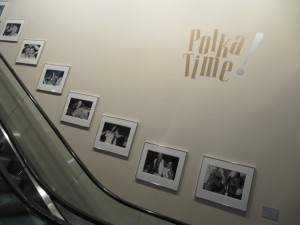
Just a clarification, the Convention Center (then Frontier Airlines Center, now Wisconsin Center) is NOT on the site of the Milwaukee Auditorium. The building still exists and has been converted to the Milwaukee Theatre, located on 6th and Kilbourn.